Stone, minerals and semiprecious of the world stone
Oxide and hydrooxide: Quartz -->rus
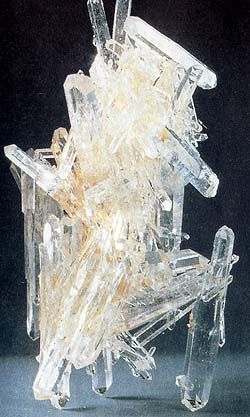 Diagnostic cart.
Diagnostic cart.
On a photo. Beautiful aesthetic group of crystals of quartz from Arkansas (USA). Quartz often forms the aggregates of crystals of largeness, usually growings one on other on a maternal rock (Druses).
Si O2
Crystal structure trigonal
Hardness on the Mohs scale 7
Specific unit weight mass 2,65
Cleavage non-existent
Fracture, break padman
Colors colourless, polycoloured (multicoloured)
Colors in powder triturate white
Glance (glitter, glare) glassy
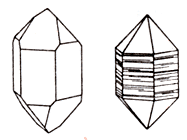
It most widespread mineral, present practically in all of rocks. It is rich in varieties, widespread and highly valued. Quartz is a xtal rockforming mineral and at the same time belongs to the number carpentry and precious stone. By virtue of the properties it is very steady both to mechanical and to to chemical influences, and that is why is the most widespread mineral on Earth, in overhead part of its bark. As a main rockforming mineral be found, as a rule, only turbid, milk, or mine, Quartz. Painted varieties of quartz, and also his colourless transparent crystals (Quartz Rock Crystal) are popular jeweller-carpentry stone.
Quartz is very proof chemically, dissolves only in hydrofluoric etching acid. Large crystals (ditrigonal) usually columnar, basaltiform, have a form of hexahedral prism with rhombohedral end verges. Quartz is important raw material for glass and ceramic industry. In a technique it is used for the generation of ultrasound, and also in radio transmitters and clock (due to the reverse piezoelectric effect of his crystals).
Quartz Rock Crystal is a crystal of typiform. The transversal shading, noticeable on the verges of prism, serves as the important diagnostic sign of all of varieties of quartz. Physical properties - typical for a quartz.
Two groups of quartz are selected. The well-shaped crystals, distinguished with a naked eye, join in one, other is made by the aggregates of microscopic crystals. In the complement of the first group enter, from one side, deprived admixtures, colourless and transparent Quartz (Quartz Rock Crystal), from other are varieties, painted in different colors, conditioned admixtures. It Amethyst (violet), smoke-coloured Quartz (Smoky Quartz), or Morione (black), citrine (yellow, gold), blue Quartz (taffy), iridescent Quartz, pink, rose Quartz, green Quartz. Admixtures can have the appearance of brilliant scales (Aventurine), needles of rutile (rutile Quartz, or hairs of Venus) or other fibred minerals ("mossiness mushroom").
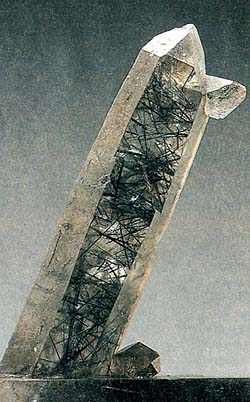 The typiform of single-crystal of quartz is a prism of hexagonal section, completed pyramids. In many copies evidently, that three verges of pyramid alternate with other three, but less size. On a photo: crystal of quartz with including of tourmaline.
The typiform of single-crystal of quartz is a prism of hexagonal section, completed pyramids. In many copies evidently, that three verges of pyramid alternate with other three, but less size. On a photo: crystal of quartz with including of tourmaline.
Chalcedony is included in the second group of varieties, Jasper, Millstone, flint stone. Chalcedony, in same queue, includes varieties, well all the acquaintances: cornelian, Agate, onyx.
Diagnostic indication.
Quartz hard strong adamantine, it can not be scratched slightly a knife (or by other sharp ferrous object). At saw or at a blow it shines a hammer yellow, that evidently in darkness (triboluminescence).
Origin provenance genesis.
It is considered that about 12% the earth's crust makes Quartz. It is crystallized together with a magma or appears under the action of fluid at a temperature 100-400 oC. So far as Quartz is very steady and hardly added weathering under the action of atmospheric factors, it is the main component of sands and other siltages. Quartz also ordinary in metamorphic rocks.
Use, practical application, deployment.
Quartz finds the most various application use: from high-tech (oscillators, stabilizators of frequencies, generators of ultrasound) to the production of glass, cleanings facilities and jewelry.
Deposit minefield mine field occurrence subsoil.
The large crystals of various form are found on Madagascar and in Brazil. Found out enormous copies weight of which is measured tons (to 40 t) in the different places of Brazil. Unusual collection of giant crystals is proposed in the National museum of natural science in Paris. Quartz often forms veins in rocks. Sometimes in them there are the rounded emptinesses (geodes) the walls of which are completely covered the crystals of quartz.
Quartz : Smoke-coloured Quartz
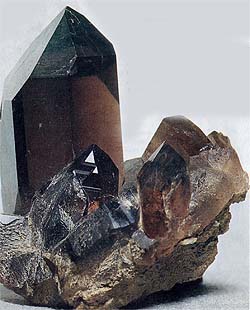 Prismatic crystals of Smoky Quartz are in a metamorphic rock. Crystals are a for a quartz typiform: prisms, crowned pyramids.
Prismatic crystals of Smoky Quartz are in a metamorphic rock. Crystals are a for a quartz typiform: prisms, crowned pyramids.
It is a very widespread variety of quartz, different from other on the color and form. Smoke-coloured Quartz be found as smoke-coloured-brown crystals of prismatic type. They often form groups from many individuals, and also twins. Their sizes hesitate from microcrystals to giant in a few meters. Colouring of Smoky Quartz is related to affecting of radionuclidess initially achroos crystals.
Greater part of crystals loses colouring at heating to 300-400 oC, other become yellow. There can be fracturing in a smoke-coloure d quartz, liquid inclusion, needle-shaped crystals of rutile, crystals of red Garnet and пустотки of geometrical outlines (negative crystals).
Deposit minefield mine and use.
Found out the most considerable deposits in Brazil, Madagascar and Sri Lanka. Giant crystals were obtained in Tizengletchere (Switzerland, Canton of Uri). Due to their beauty the best copies target at the jeweller use.
Use is on jeweller business.
At the use of Smoky Quartz on jeweller business the facet cutting, cutting a plate or steps is widespread; it is possible to apply also oval or, more rarely, rotunda. If there are interesting of inclusion rutile in a stone, preferably sphere or cabochon.
Quartz : Amethyst
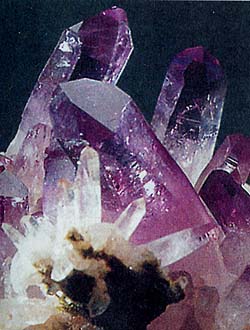 This many the glorified variety of quartz is distinguished by an enough intensive violet color. The strongly developed prism, crowned colourless pyramids, registers in many crystals of Amethyst. Colouring of Amethyst is conditioned the phenomenon of radiation emission irradiation of natural crystal, containing iron. As a rule, it is distributed unevenly: by either areas, parallel the basic verges of crystal or concentration only on completions of crystal.
This many the glorified variety of quartz is distinguished by an enough intensive violet color. The strongly developed prism, crowned colourless pyramids, registers in many crystals of Amethyst. Colouring of Amethyst is conditioned the phenomenon of radiation emission irradiation of natural crystal, containing iron. As a rule, it is distributed unevenly: by either areas, parallel the basic verges of crystal or concentration only on completions of crystal.
Glass brilliance is often hyposthenic on verges. Into a crystal it is possible to look after various inclusion: liquids are in oblate emptinesses of zigzag outlines, brown needle-shaped or rose crystals, fasciculate.
All of Amethysts at heating to 400-500 oC. With pass to the Quartz-citrine.
Deposit minefield mine and use.
Amethyst be found mainly into geodes in canks. Just the same Amethyst is observed on the deposits of Brazil, Uruguay and India. Brazilian geodes, having the rounded form, is measured on external contours cu.m.s. In Russia and on Madagascar of Amethyst fills veins and emptinesses in pegmatites. Amethysts (including artificial synthetic crystals) is used mainly on jeweller business.
Use is on jeweller business.
The use is on jeweller business. Amethyst from ancient times was the most widespread stone on jeweller business. Varieties both inconspicuous and the intensively painted cut as cabochons or Tondo or fasings, and also as a diamond. In olden times the great number of cups and other articles of the applied art was made from the aggregates of translucent Amethyst.
Quartz : Citrine
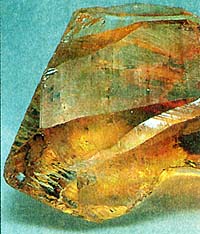 Colouring of this yellow and goldish variety of quartz by the condition presence of oxides and hydroxides of iron. Colors changes from inconspicuous- and intensively-yellow to orange-yellow and brownish.
Colouring of this yellow and goldish variety of quartz by the condition presence of oxides and hydroxides of iron. Colors changes from inconspicuous- and intensively-yellow to orange-yellow and brownish.
Deposit minefield mine and use.
Be found in the rocks of pegmatitic origin, enriched a silica, often together with tourmaline, beryl and micas. The best on a cleanness and sizes found out copies in Brazil, in an area Kampu-Bellu and Sety-Lago-as (state of Minas-zherays). In other places in Brazil, known the finds of quartz-citrine, standards are less clean and high-quality. On Ural (Murzinka) and on Madagascar were found out no less valuable crystals.
Other deposits (in which, however, the crystals of jeweller quality were not met, but it for a citrine main sphere of the use) are Pike`s Peak (El-Paso, state of Colorado, USA), Burg-d'uasan (Del'finato, France), Iniyoso-de-Duero, Villa-buenas and Villa-beso (all near-by Salamanki, Spain, EU).
Use is on jeweller business.
Citrine enough often used for cutting - for this purpose crystals must have optimum transparency and even colouring; if there is inclusion in them, they must not be visible with a naked eye. Except for the use as a jewel, a citrine is found by application use as ideal stone for the decoratively-applied aims and sculpture.
Quartz : Aventurine quartz
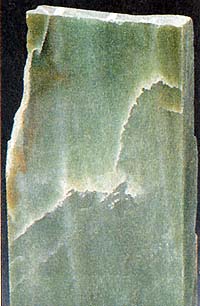 This variety does not meet as the well-shaped crystals. Massive formations are characteristic with by the great number of the chaotically up-diffused crystalline including.
This variety does not meet as the well-shaped crystals. Massive formations are characteristic with by the great number of the chaotically up-diffused crystalline including.
If light is reflected from a surface as a great number of brilliant points, it is talked about the phenomenon of "aventurine" as about twinkling, conditioned including. In aventurine of milky-green color (most widespread and in-use variety) of inclusion presented the scales of fuchsite - green chromic mica. In other cases and background colour, and reflections are related to mica of brown, white and silvery color, red anhydroferrite and blue Dumorterite.
Green quartz Aventurine contains the leaves of chrome-bearing mica as including - fuchsite, golden-brown - anhydroferrite (or muscovite). The most considerable deposits of aventurine are in India, Brazil, CIS. Used as material for making of arts and crafts and cabochon. This stone an especially favourite in the countries of South-east Asia. Entangling him is possible only with Aventurine feldspar, and green variety - with jade.
Deposit minefield mine and use.
Aventurine is not too widespread. His main deposits - in India and Egypt(developed mainly in the past), Russia, Brazil, Chile and Spain. It is met in Val'-de-Susa (a province is Turin). Aventurine is used exceptionally on jeweller business.
Use is on jeweller business.
Aventurine mainly gets cutting as a sphere for a necklace, and also ear-rings; as cabochons of oval form - for brooches and coulombs. Very rarely it is processed as a hoop for bangles. In the past from him did vases and large bottles, now - only shallow sculptures. Today Aventurine a quartz be found extraordinarily rarely, it is very difficult to meet him as wares and insertions in decorations.
Quartz : Prazeme и Prazeolite (Green Quartz)
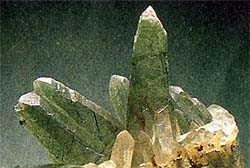 Now and then there are crystals of green variety of quartz (Prazeme). Microcrystalline the masses are more widespread, whose green colouring is conditioned including of green amphiboles and chlorites. Dense quartz aggregate. Lukovo-green a color, determining the name of stone, is conditioned including of fibres of actinolite. In Europe be found in Germany (Ore mountains), in Finland. To Austria (Zal'cburgskie Alps). To Scotland. Sometimes Prazeme is name green jasper also.
Now and then there are crystals of green variety of quartz (Prazeme). Microcrystalline the masses are more widespread, whose green colouring is conditioned including of green amphiboles and chlorites. Dense quartz aggregate. Lukovo-green a color, determining the name of stone, is conditioned including of fibres of actinolite. In Europe be found in Germany (Ore mountains), in Finland. To Austria (Zal'cburgskie Alps). To Scotland. Sometimes Prazeme is name green jasper also.
Standards, actings from an island Elba and from Mar-edzheo, are most popular for collectors. The use in jeweller aims is enough limited. If stone has an especially intensive green color, it is processed as a sphere or cabochons. It is also used for making of intaglios and shallow arts and crafts. Easily to entangle with jade.
Today Prazeme often enters sale under the name a nephrite or jadeite, although no attitude toward a nephrite and jadeite of Quartz with the green including does not have. Prazeme also can be named green Aventurine or Aventurine quartz. The crystals of Prazeme are extraordinarily rare and dear.
Spring onions-green colouring stipulated the name of Prazeolite - to this transparent green variety of quartz: in Greece prasios - green, as a leek. In nature of ideally, perfectly-transparent green Quartz of such color does not meet - with 1950 it is got burning at 500oC Amethyst and rather yellow varieties of quartz from the Brazilian deposit of Moktesuma (state of Minas-zherays). Lately facet crystal material acts also from Arizona (USA). Beryl reminds outwardly, peridotite, Tourmaline.
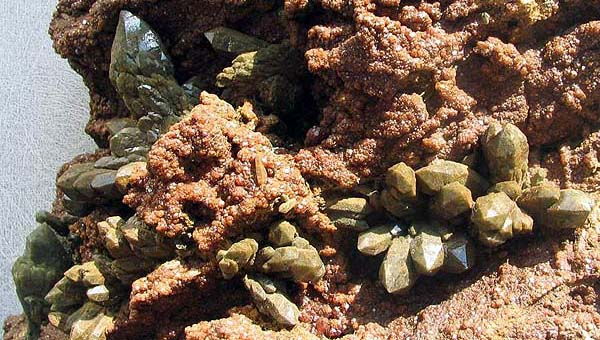
A.A. Evseev.
Quartz : Blue or dark blue (sapphire-like) Quartz
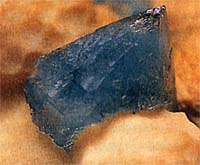 Inclusion of different minerals contains - Sodalite, dumorterite, rutile, magnetite and other Blue Quartz is used on jeweller business as carpentry stone for cutting in cabochon, for making of sculptures and mosaics.
Inclusion of different minerals contains - Sodalite, dumorterite, rutile, magnetite and other Blue Quartz is used on jeweller business as carpentry stone for cutting in cabochon, for making of sculptures and mosaics.
It acts mainly from the deposits of Brazil (Bokeyra, state of Bayya). Other notable deposits - in the USA. Dark blue Quartz is met in Italy, colouring of which is conditioned the admixture of magnetite.
In jeweller wares to meet natural and natural dark blue or blue Quartz it is practically impossible. Formative the blue crystals of Quartz be found extraordinarily rarely and costs very expensive. There is synthetic blue Quartz.
Grubozernistyy aggregate of quartz. Including of fibres of crocidolite stipulate the greyish-dark blue color of stone. Deposit minefield mine field occurrence subsoil is known in Austria (Zal'cburge), Scandinavia, Republic of South Africa, Brazil. Used as carpentry material.
Quartz : Quartz with including
 It is known approximately fifty types of minerals which can be found in a quartz as including. They are sometimes oriented on separate geometrical directions, that gives the pleasant aesthetic impression. Varieties are especially popular with the needle-shaped including of horny blende, tourmaline, chlorites and rutile. In last case mineral name the "hairs of Venus", especially if needles are goldish, direct and pointed.
It is known approximately fifty types of minerals which can be found in a quartz as including. They are sometimes oriented on separate geometrical directions, that gives the pleasant aesthetic impression. Varieties are especially popular with the needle-shaped including of horny blende, tourmaline, chlorites and rutile. In last case mineral name the "hairs of Venus", especially if needles are goldish, direct and pointed.
Quartz : Iridescent rainbow Quartz.
So transparent Quartz name, which from numerous microcracks has an iridescent effect. It appears in the conditions of the protracted tensions during crystallization in a pneumatolite phases (a type of metamorphism in which hot gases from solidifying magma react with surrounding rock). The best copies were delivered from a few deposits in Brazil (state of Minas-zherays). This variety on jeweller business is valued highly. Cutting is usually done as cabochons or sphere, as an iridescent effect the best of all shows up on the distorted surface. In Alps iridescent Quartz found in Sen-gotarde (Switzerland) and Val'-malenko (province of Sondrio).
Quartz : Розовый Quartz.
Got the name in color; often is turbid and fracturing. Crystals with the expressly expressed verges were met only recently. Colouring on fades light. Sometimes there is asterism: the thinnest needles of rutile, oriented on crystallography axes, stipulate appearance of the Hexacorallia star. Brazil serves as a main supplier of rose quartz, the most high-quality material acts from Madagascar. Processed as cabochon, beads, serves as raw material for arts and crafts. Very rare large transparent areas are subject only cutting.
Quartz : quartz aggregates.
Quartz Cat's Eye. The merge thin fibres of light fibred minerals are disposed in the downlow quartz of sub-parallel (for example, actinolite); on the surface of cabochons a narrow mobile light strip runs about at a turn: then stone indeed reminds the eye of lady-cat, from where and his name. Speaking about this stone, it is necessary necessarily to use determination "quartz", because simply Cat's Eye - it mineral cimofane. Sensible to acids. Deposit minefield mine field occurrence subsoil is known in Sri Lanka, be found also in India, Brazil. Unhardness to entangle Stone with a chrysoberyl.
Falcon Eye. It is a silicification (quartz) aggregate of bluish-grey amphibole - crocidolite with fibred texture: there is a light ebb on the polished surface; there is silky brilliance in a fracture. Stone is sensible to influence of acids. Be found in those deposits, what Tiger's-eye. Used in shallow the plastic arts, for making of beads, insertions for finger-rings and ear-rings. Rounded cabochons with a narrow light strip on a bluish-dove-coloured background cause the eyes of predatory birds in memory, from where and the name happened. Other properties are indicated in description of tiger's-eye.
Tiger's-eye. On the structure Tiger's-eye is analogical a falcon eye, in which substituted for an amphibole (crocidolite) hydroxide of iron, givings a stone a golden-brown color. An undulating ebb is created due to a thinlyfibrous structure. Glance (glitter, glare) in a fracture - silky. Unsteady to influence of acids. Be found together with a falcon eye as tabular bodies by power in a few centimetres. Amphibole fibres are oriented athwart surfaces, they developed on cracks, were afterwards deputized hydroxide of iron, and then silicification (quartz). The most considerable deposit is in South Africa, in addition, there are deposits in Western Australia, Burma, India, USA (state of Californium), Ukraine. Light reflexes are the same, as at a cat-like and falcon eye.
Quartz : common information.
Although Quartz is one of the most widespread minerals and his crystalline forms are easily added determination, him in no way it is necessary to eliminate jewels from a digit. There are not other minerals which would have such amazing violet colouring (Amethyst). Yellow Quartz can vie on beauty with topaz. Likeness them so great, that they were mixed up long time, and the only last years made authoritative persons an international nomenclature forbade to use a term "topaz" for denotation of yellow quartz. Ordinary colourless Quartz, known under the name "Quartz Rock Crystal", can be such brilliant and aquatic-transparent, that his ablaze stone sometimes named diamonds, in spite of almost complete absence in them of game of light. Such mess of the names, however, can enter in an error only quite ignorant people. Quartz primely serves in all of those cases, when the violet are required, yellow go smoke-coloured stone: it is proof enough and hard, that it can it was be carried, and has that dignity, that a price is his moderate. Nesmotrya step absence of game, it can replace pastes in some jeweller wares, as it is more proof. Quartz sometimes contains internal fibres and very beautiful "Cat's Eye" forms, which, though does not possess so bright opalescence, as chrysoberyl "Cat's Eye", nevertheless can vie with him. Quartz forms an original variety, known as "Tiger's-eye" also.
Chemically clean Quartz is deprived colouring, it water-transparent. Exactly about this variety, when it was first found out it in Alps, thought that it was a form of the frozen water, and named it a crystal (from greek crystal is ice). This variety and until now known as "Quartz Rock Crystal". Higher mentioned already, that such sparkling stone in the cut kind placed had named diamonds. So, a "Cornish diamond" or "Bristol diamond used terms in England"; there is yet a great number of the similar names, for example the "Alaskan diamond", "Arkansan diamond", "bohemia diamond". Such entering in an error names now are not used solid jewellers, because, in accordance with "Act of point-of-sale descriptions", are wrong. The name "Quartz" (quartz) was applied first, presumably, by miners from the Ore mountains. In former times the identity of material, adopted afterwards a crystal,, and shapeless the masses of silica, executing secant vein, lode, mines was not realized, and it is possible to suppose that the last in was the beginning named the word of Querkluftertz, which was abbreviated to Querertz and finally to Quartz, or Quarz, in the modern German language.
"Citrine" is the correct name of yellow variety of quartz. It originates from the French word of citron (lemon) and given to this stone because it reminds some types of these garden-stuffs a color. However, until nature of minerals was not deciphered, yellow, gold Quartz mixed up with yellow topaz. Although the real topaz a long ago is selected as the special mineral kind, many jewellers named yellow persistently, gold Quartz by "topaz", and the real topaz was distinguished addition of determination "Brazilian". A mess, thus, was only aggravated, because and yellow, gold Quartz, and yellow, gold topaz a-plenty found in Brazil. For denotation of yellow quartz were offered also the names "western", "spanish" and "false topaz", but the use of term "topaz" for denotation of quartz is acknowledged now illegal point-of-sale description.
Cairngorm (primary and more correct the name - "cairngorm stone") - brownish- or smoke-yellow, gold Quartz. It is adopted so because many standards of this variety of quartz found before in Kerngormskikh mountains in Scotland. The English word of cairngorm is the slightly changed form of gallic word of carngorm (dark blue stippler). It was wrong named scotch topaz. Stone with more thick brownish-smoke-coloured colouring are known under the name "smoke-coloured Quartz". "Morione"- the name, given to the smoke-coloured-brown or black quartz.
Rose Quartz, which, as the name specifies, has the rose-red or rose colouring, fades on a strong sun light. This variety of quartz rarely forms the cut crystals and at the best transparent only partly, and also in a greater or less degree excised cracks.
Suckling Quartz is almost opaque and reminds milk in color. Iridescent Quartz, or taffy, - it Quartz, containing cracks. It got the name from a colour effect, arising up at interference of light, falling on these cracks. Cracks can be got artificial synthetic ly, heating stone and then quickly cooling him ducking. An effect can be strengthened in such cases, entering a dye-stuff in cracks.
Colouring of quartz puts interesting and so far the not fully decided problem. Colors of minerals can be caused the presence of elements-admixtures, included in a structure either into places of atoms of staples or in intervals between them. So, the color of Amethyst was explained the presence of manganese, and color of rose quartz - by the presence of manganese or titan. However confirmed a spectrography study was not by this supposition. In one of series of researches of Amethyst were found out the sharp lines of aluminium, chrome and copper and more weak lines of magnesium and titan. Measurings, conducted on the series of standards of Smoky Quartz and Amethyst from the row of the Japanese deposits, rotined that density of colouring is proportional maintenance of iron. In paired twin (duplex) and zonal crystals of Amethyst maintenance of iron in different areas is different. Suppose now, that colouring is related to the presence of iron, however necessary it is to expect that the simple being of his atoms in a structure as an admixture will give the tints of green or yellow color. There is another way of origin of colouring, namely origin of centers of colouring as defects of structure, appearing under act of radio-active radiation. In the natural painted crystals a color is probably conditioned influence of small doses of radio-active irradiation, outgoing from containing mountain rocks. It is known a long ago, that colouring of quartz is unsteady to influence of high temperatures, and its disappearance can be bound to destruction of centers of colouring as far as renewal of primary structure.
Thermal influence causes weakening of colouring usually; if it flows long enough, and a temperature is high enough, it conducts and to complete disappearance of color. So, cairngorm (a smoky yellow, grey, or brown variety of quartz, used as a gemstone) or citrine lose colouring at the weak heating, Amethyst - prepotent, and pink, rose Quartz - at red incandescence. At more weak heating Amethyst changes colouring on intense-orange. Quartz, purchasing the yellow colouring at heating, differs from a natural yellow citrine absence of dichroism; a citrine is unchanging characterized though weak, but distinct dichroism. Since by chance discovered that some Brazilian Amethysts under act of heating can grow into transparent green stone, the process of heating was conducted intentionally and got material, being for a sale in New York under the name "praseolite" (unsuccessful choice, as a term of "praseolite" was used in mineralogy for denotation of products of change of cordierite, iolite). An irradiation is returned by a color to the discoloured quartz; thus a new color not necessarily will be the same, as lost. In most cases such Quartz becomes smoke-coloured or black, although the small stake of crystals acquires colouring of citrine. There is the quickly vanishing blue colouring at the repeated heating of some stone. Nastoyaschego of Amethyst of color does not arise up, although there are reports about the synthesis of Amethysts at growth of crystals of quartz in steel autoclaves.
Prazeme, or "mother of emerald", as it was sometimes named, supposing that it is a maternal rock for emeralds, - it Quartz, painted in a spring onions-green color due to including of fibres of actinolite (calcium-magnesia silicate). A word "Prazeme" (British prase) originates from a greek word "bow". This name is added also to the similarly painted microcrystalline aggregates of quartz (Chalcedony).
Quartz (along with a corundum) in regard to simplicity of chemical composition disposed among jewels after a diamond being simply the oxide of silicon, or silica of SiO2. At high temperatures a silica forms other structural modifications.
X-ray, roentgen the study of crystals of quartz confirmed a conclusion, done on the basis of morphological and optical characteristics, namely, that the structure of quartz has spiral, I.e. spiral character; in accordance with it two types of structure are selected - right-side and left-side. Indeed, Amethyst unchanging presented separate crystalline individuals-twins which are alternately right-side and left-side crystals. In some crystals in a cut, perpendicular the rib of prism, it is possible to sm three-cornered sectors which are presented alternating right-side and left-side quartz and have the different colouring - violet and white.
In accordance with the type of symmetry, Quartz is optically a monaxonic mineral and has two main indexes of refraction - usual and unusual. Size of the first - 1,544, and second - 1,553; the size of maximal birefringence is equal 0,009. That deviations from the indicated sizes are observed very rarely, proves the chemical cleanness of very thin material. For some painted stone insignificant growth of sizes of indexes of refraction was marked to 1,545 and 1,554 accordingly.
The closeness of quartz is surprisingly permanent, though more changeable, than size of indexes of refraction, from the presence of emptinesses and including. Closeness of mountain crystal 2,651; closeness of citrine, Amethyst and rose quartz hesitates from 2,647 to 2,656, and the closeness of aventurine arrives at 2,66-2,68. Hardness on the Mohs scale quartz on Mohs hardness is equal 7. Quartz does not scratch a steel knife and steady to abrasive influence of ordinary dust. It does not possess cleavage.
Except for fibred differences, processed as cabochons, to expose the effect of "cat's-eye", Quartz usually expose to the step or diamond cutting in accordance with setting of stone. In addition that Quartz gives jeweller material, it is very valuable minerals. Because of high hardness of Quartz sometimes prefer glass as material for making of lenses for glasses, because it is uneasy to scratch such lenses at the ordinary carrying and their surface saves a polish very long time. Quartz excels glass on transparency for ultraviolet rays to which a film is most sensible usually, therefore it is applied for making of lenses, in-use at thin photographic works. Marbles from a colourless transparent quartz are valued admirers and lovers of beautiful stone.
Due to the piezoelectric properties of Quartz enough unexpectedly appeared invaluable material for making of stabilizators of frequency of radio waves. In quartz plates, bars or rings it is possible by means of electric excitation to cause a vibration, and stability of mechanical vibrations can provide stability of electric vibrations. A that circumstance is thus used, that amplitude last unusually increases in that case, when their frequency coincides with frequency of the first. The same principle is used for creation of high-fidelity clock. Obviously, that the crystals of quartz, in-use for such aims, must not contain tracks of double, because otherwise piezoelectric axes would be distorted and a capacity for vibrations is broken. ' Experience rotined that many crystals of quartz, which seemed monopure, actually there are twins and useless as regulators of vibrations.
Quartz sand is widely used as an abrasive for making of "hide" and clearing pastes, and also as component part of glass шихт. At melting in oxygen-hydrogen flame of Quartz grows into quartz glass which possesses completely other physical properties as compared to ordinary glass. A birefringence non-existent at quartz glass, and the size of index of refraction goes down to 1,460. Dispersion is equal 0,008. A closeness goes down to 2,2, and hardness diminishes to 5 on Mohs hardness. Quartz glass is widely used in laboratories and in home everyday life, because it maintains the rapid and uneven heating without a risk to crack. It can be prolate in a fibre, so thin, as well as silk, but not having a characteristic for silk tendency to the wring, and such fibre invaluably in thin torsion experimental devices, for example in devices, in-use for determination of mass of Earth.
Quartz is one of those jewels, which are most easily added determination both on optical properties and on a closeness. The painted border, visible at illumination white light on ordinary refractometer, is very characteristic and sharply differs from a picture, looked after in the case of glass with the same refractive ability. The closeness of quartz also differs from the closeness of other jewels which it can be entangled with.
Colors Amethyst is so original, that for determination of this stone it is not required to conduct some researches. Most easy to entangle with other jewels of the that colouring of yellow, gold Quartz and citrine. Mentioned already, that easily to take them for topaz. Immersion in an iodine methylene allows immediately them to recognize, because topaz sinks in him, and Quartz with lightness emerges. As sour orthorocks are determined as rocks, containing surplus of silica, in such rocks usually there is a lot of quartz. It is also main component part of sandstones, appearing due to destruction of sour rocks. Quartz enters as main component part in many metamorphic rocks, often executes geodes and vein, lode, mines, where well well-educated crystals are.
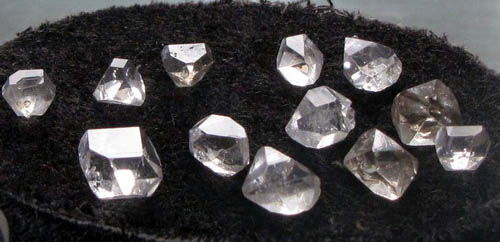
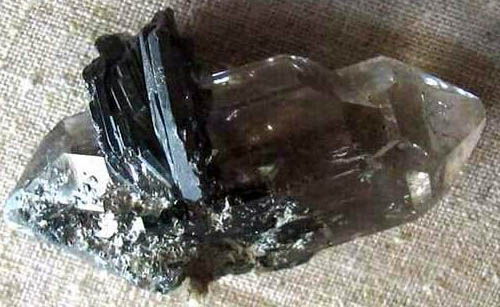
The brilliant, clean crystals of mountain crystal are found in many districts of earth. This variety, as already mentioned higher, was first met among eternal snows in Swiss Alps and got the name "crystal". Good crystals take a place from Burg-d'uazana in the department of Izer in France, from the marble quarries of Karrary in north Italy and from Marmaroshskaya array in Transcarpathian. Rolling pebble of mountain crystal, taken from Alps to Rhine, obtained before in Idar-obershteyne and were adopted "Rhine stone" ("by river Rhine stone"). It is the name, unfortunately, began wrong to add to the different counterfeit jewels, to intagliated from synthetic glass. Small brilliant crystals got on the places of the finds such entering in an error names, as "diamonds of island of Uayt", "Cornish diamonds" or "Bristol diamonds". Similar material is found in neighbourhood of Tandzhor in state Madras is in India, where it is used for making of the cheap jeweller hand-made articles and carries the name "wallume- diamonds ". In the valley of the river Ind from such stone is made by necklaces; here these stone are named by "mari-diamonds". Japan supplies with the beautiful standards of quartz, especially "Japanese twins" which two crystalline individuals are isolated in, and directions, parallel the ribs of prisms, are located almost at right angles to each other. Good Quartz Rock Crystal obtain on Madagascar and in the different districts of the USA. Enormous amount of excellent material, in-use in an optics and electrical engineering, Brazil supplies. The transparent pieces of quartz have so largenesses sometimes, that stone lovers gave a shape them balls.
Brazil is famous also magnificent Amethysts. A main district of their booty is in state of Riu-grandi-du-sul, from where it extends through a state boundary to Uruguay. Amethysts is met and on many deposits in the USA. Recently reported about the find of very large crystals in Dyo-ueste in state South Carolina. Material from For-piksa in state Arizona acquires the green colouring at heating, reminding in that behalf "praseolite" from Montezumy in Brazil. These crystals are similar on a habitus with crystals from Sander-Bey on a lake Overhead. Good crystals were extracted from pebbles shingle on Ceylon, and also obtained on Ural. The booty of quartz was made in the prefectures of Etigo, Khoki and Ivaki in Japan. Suppose that material, appearing at the market in Africa, takes a place from Tanzania; other sources here are Zambia and Namibia. Among the Australian deposits it is necessary to mention the mine of Uilu-steyshen in neighbourhood of Ashberton in Western Australia. In Ireland in a bay Kim-Bey on the island of Ashill rose-purple crystals are found. Sarkstoun - Amethyst, found on the island of Sark in a channel La-mansh; however already during great while here no longer find these stone, and standards, sold tourists under this name, are either the imported material or imitation. Three magnificent cut standards of Amethyst are in Gallery of minerals of the Britannic museum of natural history. The largest from them, weighing 343 carats, has an oval form and found in Brazil. Two other brought from Russia. One of them has hexahedral outlines and weighs 90 carats; other, thick violet color, has the rounded form and weighs 75 carats. Excellent quality of cairngorm before in large amounts found on the mountain of the that name in Scotland, but now it be found rarely. It until now highly has pups and widely used in this country as decorations, especially in the suits of highlanders. At one time cairngorm it is possible it was to find in a number of places in central part of Grampianskikh of mountains. Separate crystals arrived at weight of a few ten of pound, and once the most amount of this stone was extracted from one large cavity in granites. Other deposit of brown quartz was Gotfell on an island Arran.
Very plenty of Smoky Quartz, sometimes as exceptional large crystals, was found in Swiss Alps. Smoke-coloured Quartz, becoming at heating yellow, met near Kordovy in Spain. In the USA beautiful kerpgorm is found on the mountain of Pike`s Peak in state of Colorado; excellent material is met also in a number of other deposits. The large crystals of Smoky Quartz and Amethyst take a place from western part of district of Keroll in state New Hampshire (USA). Correct crystal, found in Stounkheme in state Maine together with numerous more shallow crystals, had length 117,5 sm, thickness 42,5 sm and weighed 230 kg In Asia good material takes a place from the district of Nerchinska and from Manchu. Magnificent citrines is met in many Brazilian states, especially in state of Minas-zherays, San Paulo and Goyas; here citrines often mix up with topazs. Assert that yellow, gold Quartz, described as a citrine, be found in many other deposits. It is talked that a citrine be found among jewels, supplied from Madagascar. In England the finds of citrine are described in Kornuelle, and some painted crystals of quartz from Gotfella on an island Arran was also named citrines. However here again it should be noted that majority of yellow quartz, given out for citrines, got as a result of heat treatment of Smoky Quartz or Amethyst. Wonderful pink, rose Quartz be found enough rarely. It was obtained in the valley of the river Zhekitin'on'ya in Brazilian state of Mipas-zherays; from pegmatites of Namibia; jointly with a citrine and smoke-coloured quartz on Madagascar; in Goto in the prefecture of Ivaki in Japan; in Bodenmayse in Bavaria; in Pirise in state Maine and near Kastera in the mountains of Blek-khils in state South Dakota is in the USA; on Ural (Russia, CIS).
Silicon is a one of major macronutrients. In an organism participates in forming of connecting and ephithelial tissues, instrumental in growth of hairs and nails, stimulates phagocyte-lake It is contained as different compounds, participating in formation of hard (skeletal is tissues in bones) parts and tissues. The deficit of silicon can develop at the insufficient entering of element organism (5 mg/day and less).
There is about 1 g of silicon in the organism of human people. In an organism mastered about 4% from the general amount of acting silicon. Among internalss a leader is a thyroid - a to 310 mg of silicon accumulates in it. A table of contents of silicon in tissues of cerebrum is 0,001-0,01%, a hard (external outer) brain-tunic, cortex (covers a brain) and cerebellum, is rich them. The concentration of silicon in a cerebrum depends on the state of cns (cerebrum), for example, at excitation of cns his amount diminishes in tissues of brain, and at braking - increased (psychiatry).
Soluble compounds of silicon are sucked in in a thin and duodenum bowel. From data of spectrology, in daily products, selected the healthy organism of people, maintenance of silicon is equal 4,7%. accessory supplemental reception is recommended at illness of Alzheimer's sclerosis, osteoporosis, cardiovascular diseases. Silicon is well mastered together with a molybdenum, magnesium, fluorine, and also cellulose (carbon).
At any chronic and sharp pathology a requirement in silicon is increased, and the enhanceable reception of this element conduces to the improvement of feel and helps an organism to manage with illness. Silicon is rotined and for maintenance of health of nails, skin and hairs. Origin of many pathological processes, including shrine, atherosclerosis, tuberculosis, diabetes, goitre, dermatitises, stone in urinoexcretory ways, it is often related to violation of exchange in the organism of compounds of silicon.
Signs and symptoms of insufficiency. Loss of elasticity (that results in the acceleration of processes of senescence), caries and parodontosis, amphodontosis, fragility of nails and psilosis, blood vessels. Medical properties of silicic water are widely known. Silicic water is the simple mean of addition to the concentration of this vitally important matter in an organism. One of most saturated silicon a natural source is blue (contains radio-active uranium), medical (yellow-brown color, with gold and iron), food clay (white, a kaolin is a kimberlite).
Enhanceable maintenance of silicon in an organism be found at workers of extractive industry at contacts with an asbestos, quartz, aerosols, cement, by glass et cetera, in localities in plenty of compounds of silicon in water and in mid air. Systematic inhalation of dust, containing a free silox in high concentrations, results in development of schistosis (Quartz Rock Crystal) is illness of diamond cutter of the stones. Displays of surplus of silicon: fibrosis of lights; urolithiasis; malignant tumours of pleura and abdominal region.
